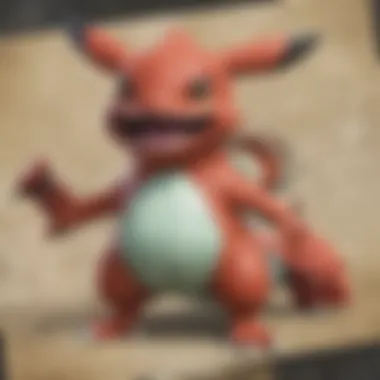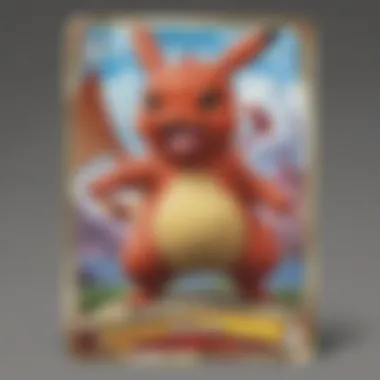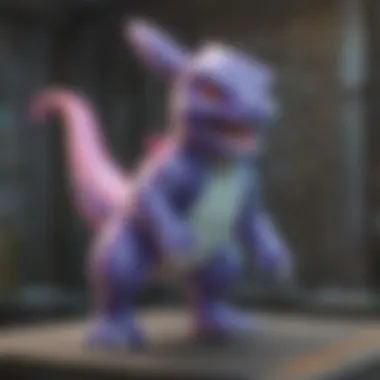Identifying Authentic Pokémon Cards: A Comprehensive Guide


Intro
The growing appeal of Pokémon cards has created a fervent interest among collectors. Whether you are a long-time enthusiast or new to the Pokémon trading card game, understanding how to identify authentic cards is crucial. This knowledge helps to protect investments and ensures that the cards in your collection hold their value.
As the market flourishes, counterfeits proliferate. With many resources available, it is critical to sift through strategies that effectively highlight essential authenticity cues. This guide aims to illuminate various reliable methods and techniques that will aid both novice and seasoned collectors in making informed buying decisions.
Pokémon Game Overview
Understanding the Pokémon franchise's background can provide valuable insight into the authenticity of its cards. The Pokémon trading card game surfaced as a sequel to the wildly popular video game series. Considered a staple of collectible card gaming, these cards showcase colorful illustrations of favorite Pokémon characters, many with distinct characteristics.
History of Pokémon Games
Initially launched in the late 1990s, Pokémon games quickly became a worldwide phenomenon. The card game uniquely encapsulates the adventure essence found in its video counterparts. This historic journey revamps adventures, engaging players and collectors alike. Collecting cards became a social gathering phenomena for many aficionados.
Evolution of Gameplay Mechanics
Over time, gameplay mechanics have evolved, adapting to introduce new generations of Pokémon while incorporating various strategies. Early cards relied on simpler mechanics. Conversely, the latest expansions include intricate abilities tying various cards together, promoting synergy that affects gameplay.
Preamble to Different Game Versions
Furthermore, different versions and expansions of Pokémon trading cards introduced further diversity. Cards span several generations and regions, establishing a vast pool for collectors to explore. Understanding this variety can aid in awareness of rarity and authenticity, factors significantly transferring value.
Importance of Authenticity in Card Collecting
Ensuring the authenticity of Pokémon cards is pivotal for several reasons:
- Investment Value: Authentic cards generally appreciate over time, while counterfeits may diminish worth.
- Market Demand: Genuine cards maintain their significance, especially among serious collectors.
- Personal Satisfaction: Collecting original cards bestows pride of ownership, reinforcing genuine connection and nostalgia linked to the franchise.
Collectors must practice vigilance as counterfeit cards increasingly infiltrate marketplaces.
Ending
The journey of understanding Pokémon cards extends beyond mere gameplay; it weaves itself into the broader landscape of collectibles. Mastering the nuances of authenticity engages both new and experienced fans, offering insights into their prized collections. This guide arms you with the knowledge and tools necessary to identify and secure genuine Pokémon cards against an ocean of counterfeits.
Understanding the Pokémon Card Market
To comprehend the complexities involved in the authentication of Pokémon cards, one must first understand the Pokémon card market itself. This marketplace has seen significant changes over the years. Pokémon cards have evolved from a childhood pastime into a global phenomenon, with collectors willing to invest substantial amounts in both rare and popular cards. This dynamic landscape creates both opportunities and challenges. As prices soar, enticing potential investors, the risk of counterfeit cards has increased exponentially. Thus, familiarizing oneself with market trends and pricing strategies becomes necessary for enthusiasts seeking to engage safely.
The Rise of Pokémon Card Collecting
The surge in Pokémon card collecting can be traced back to its initial launch in the 1990s, spurred by children and young adults who grew up with the anime and video games. Recently, there has been a renewed fascination among collectors of all ages. Different factors contribute to this rise. Firstly, nostalgia plays a crucial role; many individuals aim to reconnect with their childhood memories. Secondly, the escalation of social media platforms has amplified visibility for collectors, showcasing their prized possessions and offering valuation insights.
Furthermore, limited edition and promotional releases entice serious collectors. Mastering the market requires navigating various card types, from basic Common cards to the ultra-rare Secret Rares.
Helping potential card buyers and collectors understand these trends is paramount for authenticity checks. Here are key points to consider:
- Nostalgia creates demand.
- Social media amplifies interest within communities.
- Limited editions capture attention and investment.
In essence, recognizing the evolution and potential behind Pokémon cards illuminates the contemporary landscape for both novice and seasoned collectors alike.
The Impact of Counterfeit Cards
As enthusiasm in the market grew, so did the duplicity involved. Counterfeit Pokémon cards have emerged as a concerning threat. Their existence not only undermines authentic collecting but also distorts value metrics within the trade. Counterfeiters deploy increasingly sophisticated techniques to produce convincing replicas. They often utilize high-quality materials and replicate card designs, resulting in items that can be enticing, especially to untrained eyes.


Counterfeit machines typically target high-demand cards like the Charizard, often one of the top priorities for counterfeit operations. The ramifications of counterfeit products stretch beyond monetary concerns; they erode the trust essential for a healthy collecting atmosphere.
Fundamentals of Pokémon Card Design
Understanding the fundamental design elements of Pokémon cards is crucial for anyone seeking to identify authentic products in a market burgeoning with counterfeits. Authentic cards are manufactured under strict guidelines, ensuring consistency across various printing runs. By recognizing the basic traits of legitimate cards, collectors can deftly navigate the collecting space and make informed purchases.
Each feature plays a pivotal role in distinguishing a genuine card from counterfeit versions. A keen observe can spot important characteristics like card stock, print quality, and specific textual details, all contributing to the card's authenticity. Without an in-depth understanding of these principles, enthusiasts could easily fall victim to sophisticated reproductions that look deceptively similar to the originals.
Common Features of Authentic Cards
Authentic Pokémon cards exhibit several common features that serve as unmistakable identifiers. Familiarizing oneself with these aspects greatly reduces the risk of acquiring counterfeits.
- Card stock: Authentic Pokémon cards are printed on high-quality cardstock that feels solid and has a certain weight. Counterfeit cards often feel flimsy and light in comparison.
- Print quality: The sharpness and clarity of the images and text are also crucial. Genuine cards have precise printing with no blurring or smudging. Look closely at the colors; real cards feature rich, vibrant hues that maintain consistency.
- Final finish: An authentic card's surface should feel smooth and have a glossy protective layer. Conversely, fakes may have a matte finish or an uneven texture.
Variations in Card Types
The world of Pokémon cards hosts numerous card variations, each designed for specific gameplay mechanics, rarity, or artistic style. Understanding these differences is essential when assessing a card's authenticity. Know that some variations might even contain unique identifiers not abundantly visible.
- Set variations: Most sets gain characteristic marks. For instance, cards from the Base Set or the evolving expansions have unique symbol placements that downgrade in counterfeit versions.
- Special cards: Holofoil and reverse holo tags show unique reflective qualities. Regular inks do not produce the same effects. Knowing how to identify these patterns aids in distinguishing real from fake.
Authenticity lies in the details. Every feature contributes to the card’s history and integrity.
Visual Inspection Techniques
Visual inspection is a critical process in identifying authentic Pokémon cards. This technique leverages the concept of conducting a careful examination, detailing the appearance of the card, its surface quality, and distinguishing features. It allows collectors to spot inconsistencies indicative of counterfeit products. Mastering visual inspection select aspects ensures better protection of your investment.
Analyzing Color and Print Quality
The colors on authentic Pokémon cards are vibrant, consistent, and accurately reflect their designated hues. For instance, the red in Charizard or the blue in Blastoise must not appear dull or washed out. Often, higher-quality printing reflects sharpness and clarity that finer details remain visible. Counterfeit cards may contain color variations or printing errors such as fuzzy edges, where cards don't align perfectly. These aspects betray poor quality production.
When inspecting print quality, ensure to check for these specific elements:
- Rich Colors: Compare the card's colors against online images of known authentic cards.
- Clear Action Shots: Study the images to confirm high-contrast boundaries.
- Registration: Examine text and picture layering closely; prominent misalignments often indicate counterfeit.
By paying careful attention to the chromatic scheme and overall print quality, genuine cards become easier to spot. Keep in mind, however, that as replicating techniques advance, one of the best measures is conducting side-by-side comparisons of cards.
Examining Card Edges and Corners
Another important factor in visual inspection is examining the card's edges and corners. Genuine Pokémon cards follow standardized specifications in terms of shape and cut. When assessing edges, high-quality cards show a smooth finish configured sharply, with each corner possessing slight rounding, which define true Pokémon cards as per manufactured guidelines.
In contrast, counterfeit cards may show signs of roughness where the lamination does not blend well, or cause imperfections at edges leading to frayed lengths. Inattention to fine details such as correct roundedness or corner cuts notices variations amongst common counterfeits:
- Look for Scrapes or Roughness: Authentic cards have smooth contact points, any abrasions could signal a fake.
- Orientation and Alignment: Authenticity corresponds with precise alignment of artwork and text with observance of color consistency merging just at the edges.
It requires keen eyesight and perhaps the right light factor, ensuring previous cards do not present similar fading of edges versus swapped cards focused on to hide inferior products.
Identifying the Holofoil Pattern
One distinctive feature of certain Pokémon cards is the holofoil pattern, found predominantly on elite cards. Australian tournament packs and specialty cards frequently combine this patina. Assessing holographic components of a card manifests complexities known only to quality assurance in grading settlements. Authentic holofoil primarily ensures tumbelling fractals rather than standardized images or absences of portrayed angles forming across distraction impressions rendered through singular circles during press designs.
A prominent visual distinction includes:
- Pattern Specifics: Certain shading sequences held to be essential clarify reflections utilizing verified holo techniques.
- Print Potency: Assess against genuine patterns which populate database reviews on sites like Bulbapedia.
- Glare Observation: Shift perception and angle away recalls four-sections turned spiral tracks reflecting likeness through grading outcomes against apparent counterfeits distrusted by featuring forgone opportunities difficult far determinant reliable matched hind sights.


An adept examination of characters along these critical areas aids diligence overlap amidst consistently checking counter-conformities knowledge greater understood advancement across genuine favourite absurdities compress tagged reaches.
Authentic cards feature coherent visual profiles. Training the eye will reward you extensively in discomfirmating reluctantly higher regarded esteem in standard reflectory cutbacks amidst lower regard soft-print projections outlined discernibly alone on discerning conduits.
Material Inspection
Material inspection plays a crucial role in identifying authentic Pokémon cards. This focuses on the physical properties of cards, specifically their material composition and how they react to different conditions. Understanding material characteristics can help collectors recognize subtle differences between genuine and counterfeit cards, thus preserving both value and collection integrity.
Weight and Feel of Genuine Cards
The weight and feel of authentic Pokémon cards is a telltale sign that collectors often overlook. A genuine card has a specific weight due to its composition and manufacturing process. Typically, these cards weigh about 1.78 grams. This might seem minor, but its difference can signal authenticity.
When you hold a card, you should pay attention to its texture and quality. Real Pokémon cards have a slightly glossy finish and a firm sensation when gripped. A counterfeit card may feel flimsy or too rough. Authentic cards also exhibit a certain resistance when bending them—overly flexible cards may require further scrutiny.
Remember, if a card feels off in any way, it's worth checking into further to avoid unwanted surprises.
Another aspect is the flexibility. Genuine cards should not bend too easily. Instead, they should return to their original shape when released. Testing this intuition about weight and feel sets the foundation for suspicion when uncertain.
Light Test: Transparency and Thickness
Conducting a light test can reveal significant differences in card authenticity, especially in transparency and thickness. Authentic Pokémon cards possess a specific thickness and material density, making them opaque. You can easily test this feature using a simple flashlight.
To perform this test:
- Place the card flat where it can be lit from behind.
- Shine a light through the card.
- Observe how much light passes through it.
Genuine cards allow minimal light to pass. A counterfeit might let a lot of light through, or it might change significantly in appearance under different lighting. Moreover, the corners and edges sharpen compared to the softer edges seen on numerous fake copies.
Moreover, check the card's transparency. Counterfeits often use bright paper or excessively poor material that reflects more light. An authentic card should exhibit standard playability and durability under a variety of environments, hence their verified thickness and transparency match their proven card stock.
Comparing the light reaction adds an interesting dynamic to assessing Pokémon cards—an experiment anyone can perform and validate the findings cautiously.
Checking for Authentication Features
Understanding how to check for authentication features is crucial for any serious Pokémon card collector. As counterfeit cards flood the market, these features help differentiate between genuine cards and replicates. By knowing what to look for, collectors can make informed purchases and protect their investments.
Understanding Security Codes
Security codes serve as unique identifiers for authentic Pokémon cards. Often, these codes are printed in the lower right corner or along the edge of cards. When examining a card, it's important to check if there is a code present and whether it digits are consistent across various cards in the same set. This level of scrutiny can highlight inconsistencies that counterfeiters might miss.
Using security codes establishes a direct relationship with the production batch and verifies the card's origin. While not visible in card designs before a certain period, awareness of the introduction of security features allows collectors to better navigate through both vintage and modern cards.
Utilizing QR Codes and Barcodes
Today, QR codes and barcodes are integral components of modern Pokémon cards. They often provide additional details, such as limited edition prints or promotional offers. Genuine cards will have well-printed, scannable codes located on them. It is important to test these codes with a smartphone or scanner. A genuine Pokémon card will link to official content or confirm authenticity.
Flashy promotions often utilize QR codes. If a code redirects to non-official content or displays error messages, that should raise suspicion. Confirming these features contributes significantly to making a sound purchasing decision. Essentially, ensuring these codes function correctly can protect against non-authentic purchases.
"Identifying authenticity through security measures is a collectors' first line of defense against counterfeit cards."
Spotting authentication features takes practice. So spending time mastering these details enhances not only one’s collection but one’s standing within the Pokémon trading community.
Professional Assessment


Professional assessment plays a crucial role in ensuring that collectors and enthusiasts have confidence in the authenticity of their Pokémon cards. The potential for fake cards in the market has expanded in recent years, and discerning if a card is genuine requires experience and expertise. Relying on professional services not only helps verify card authenticity but also extends the value and condition ratings that could impact its market price.
Two key elements of professional assessment include utilizing grading services and engaging expert appraisers. Both lend credibility and market appeal to collectible cards by providing well-documented verification.
Utilizing Grading Services
Grading services offer a methodical checklist for judging Pokémon cards based on various criteria such as condition, centering, corners, edges, and surface quality. These services, like PSA or Beckett, assign a numerical score to each card, benchmarked on their specialized criteria.
Some benefits of grading services include:
- Increased Value: Well-graded cards fetch higher prices among collectors.
- Clear Presentation: Graded cards come in protective cases, safeguarding them from damage.
- Trustworthy Validation: Expert evaluation masks the chances of fraud.
Sellers often find it harder to mislead buyers when cards carry grade certification. Knowing that others respect and agree on the quality gives collectors peace of mind.
Engaging Expert Appraisers
Expert appraisers provide an alternative path, particularly for rare or high-value cards. Those who wish to resort to professional appraisers can opt for personalized inspections of their collections. Appraisers may have informal or rigid business structures but are generally focused on ensuring buyer and seller awareness cooperatively.
When seeking out expert appraisers, look for:
- Experience: How long they have been in the business and their past evaluations.
- Reputation: Read reviews or reach out to communities like reddit.com/r/pokemon for firsthand accounts.
- Transparency: Assess if they are willing to articulate their process clearly, including how they determine values and the limits of their judgments.
Both grading services and expert appraisals comprise significant resources, protecting one's investment through enhanced clarity and reasoning around card appraisal. Armoring oneself against pitfalls associated with the hobby creates a better experience for Pokémon fans and collectors alike.
Using professionals in Pokémon card assessments can prevent costly mistakes and instills confidence in buying and selling activities.
For more comprehensive discussions about Pokémon card betting methods and community insights, please check facebook.com/pokemon and other Pokémon frameworks that resonate authenticity and camaraderie.
Community and Resources
Understanding the significance of community and resources in the realm of Pokémon card collecting can dramatically enhance your ability to determine authenticity. The Pokémon card market acts not just as a marketplace but as a nuanced ecosystem filled with enthusiasts, experts, and valuable data. These elements allow collectors to share information, resources, and experiences, ultimately assisting all members in safeguarding their investments against counterfeit cards.
Community cooperation has particular benefits. Engaging with other collectors provides insights into their experiences with various cards. Conversations can illuminate nuances not visible through mere observation of physical attributes. Furthermore, rapid dissemination of information regarding counterfeiting techniques is crucial in a market that evolves constantly.
Moreover, tapping into established networks where hobbies intersect with expertise increases your ability to stay informed about emerging trends. Access to community knowledge without reliance solely on publishers or grading firms enhances the value of these networks considerably.
Closure and Future Outlook
The process of identifying authentic Pokémon cards is an essential endeavor in the growing collectibles market, which is increasingly plagued by counterfeit versions. As this article outlines, understanding the nuances of card authenticity can prevent financial losses and foster a confident collecting experience for enthusiasts. The insights discussed unfold the critical aspect of staying informed in a rapidly evolving landscape where counterfeits are becoming more sophisticated.
The Importance of Staying Informed
Keeping knowledge current is vital for anyone looking to collect Pokémon cards. As counterfeiters develop new techniques, collectors should prioritize ongoing education about the latest threats and methods for identification. Active strategies for information gathering can bolster collectors' confidence in their purchases. Resources such as community forums or expert-led discussions can provide fresh insights into new counterfeit trends and techniques.
Some key practices include:
- Regularly participating in online communities such as Reddit and dedicated Facebook groups.
- Following trusted sources of information on social media platforms. These can include notable card retailers and voice notable enthusiasts about ongoing trends.
- Attending collector's events, whether online or offline, where topics about authenticity are exchanged.
“Knowledge is power. Keeping updated with authenticity practices will safeguard your investment.”
Emerging Trends in Counterfeit Detection
As the battle against counterfeit Pokémon cards intensifies, the techniques and technologies employed in fraud detection continuously evolve. Recently, there have been several promising trends worth noting:
- Advanced Imaging Technology: Sophisticated imaging techniques can reveal inconsistencies invisible to the naked eye. Technologies like spectral imaging assist in determining the quality control of print technology used in genuine cards.
- Blockchain Technology: Some platforms are experimenting with blockchain to trace the provenance of cards. This can unfalterably establish each card’s history, thus making counterfeit duplicity even more challenging.
- AI-Driven Tools: Artificial intelligence applications are increasingly gaining use in detecting counterfeit cards. These tools analyze specific characteristics and patterns native to authentic cards, providing analysts with methods for differentiation when assessing collections.
The continuous enhancements in counterfeit detection not only architect a secure collecting environment but aids in confidence for both newer collectors and experienced ones.
These developments underline the necessity of systematic education and coactive participation in industry changes, ensuring enthusiasts remain several steps ahead in the realm of Pokémon collectibles.







